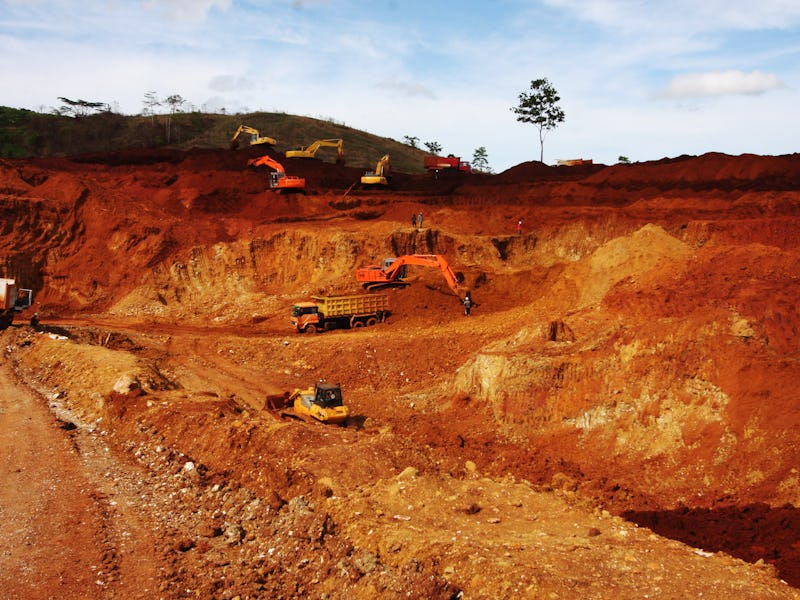Nickel: everything you need to know about Elon Musk's new favorite mineral
Nickel has helped build the modern world, and that's why Elon Musk needs more. But it can come with a tremendous price.

As Tesla continues onward in its world-beating path of global domination, the company needs more resources. In a recent post-earnings call this week with stockholders, CEO Elon Musk issued a plea to “any mining companies in the world”:
Wherever you are in the world, please mine more nickel and don’t wait for nickel to go back to some long...some high point that you experienced some five years ago whatever. Go for efficient, environmentally-friendly nickel mining at high volume.
While in many instances, Musk is eager to stand apart from the rest of the world’s car manufacturers, here they likely stand shoulder to shoulder. Nickel is heavily used in electric car batteries, and research firm Wood Mackenzie estimates that demand for the mineral will increase by 64 percent between 2019 and 2025.
But Musk’s call is a tough one: The industry, as Wood Mackenzie notes, is slow to add capacity. It’s also expensive. At its current pricing, around $13,000 a ton, nickel is actually a bargain at the moment. Let’s break down the challenges that Musk and the rest of the EV world will have in getting more of this precious mineral.
What is nickel? Nickel is a naturally occurring mineral that humanity has interacted with for several millennia. Some historians believe that artisans in Syria over 2,000 years ago used the mineral as an alloy to strengthen their pieces, but it was first brought into the scientific world in 1751 by Swedish chemist Axel Fredrik Cronstedt. At the time, copper was among the most valuable minerals in the world, and Cronstedt gave this new mineral the name “Kupfernickel,” or Devil’s Copper, declaring it a sort of Fool’s Gold.
The Nickel Institute, a trade organization that represents nickel mining operations around the world, estimates that there are around 300 million tons of nickel around the world. That would make it the fifth-most common mineral in the world.
The Tesla Model Y uses nickel in its battery packs.
Besides electric cars, what is it used for? While some scientists didn’t accept Cronstedt’s findings until the 20th century (they thought nickel was cobalt), the mineral would quickly prove its worth.
Around two-thirds of the world’s nickel is used to make stainless steel, which can be found in kitchens across the globe, not to mention, cars, trains, and waste management treatment plants. After that, around 12 percent of the world’s nickel is used to create Inconel 600, a lesser-known superalloy that is used in everything from transport barges to car mufflers. Alloys make up the vast majority of uses after that, taking a wide variety of shapes.
A stainless steel bowl.
A 2019 report from the United States Geological Survey noted that “production of nickel chemicals, however, has increased, particularly nickel sulfate used in the production of batteries.” So while the mineral is in high demand for a variety of reasons, Tesla and other electric vehicles are making an impact.
In August 2019, nickel producer Terry Bradford told the Detroit Free Press, “The big question everyone will be asking in a year’s time is where does the nickel come from to satisfy the demands for nickel in stainless steel, as well as the increasing demand for nickel into electric vehicle batteries?”
Nearly a year later, Elon Musk is asking that exact question.
The Toyota Prius, the world's first mainstream hybrid vehicle, introduced in 1997. Its battery used nickel.
What makes it so useful? Nickel’s ability to easily strengthen materials, combined with its high melting point (over 1,400 degrees Fahrenheit), resistance to corrosion, and magnetic properties at room temperature, make it a natural choice for any number of uses.
As the material developed, uses in transportation became clear: in 1906, a 366-ton German racing yacht named the Germania was built with a chrome-nickel alloy hull and was eventually captured by the British as a prize of war in World War 1. At the end of the century, when the Toyota Prius was introduced in 1997, the company chose nickel-metal hydride batteries for their extraordinary longevity.
While the batteries of choice in the EV industry have changed since 1997, nickel still remains very useful. As Cecilia Jamasmie Mining notes, “using nickel in battery cells helps to make them energy-dense. This means that those batteries can be smaller, lighter, and can make cars run further on a single charge.”
A staff worker in a nickel mine in Jinchuan, China in January 2020.
Heavy trucks working at a nickel mine in Indonesia in 2019.
Nickel ore being processed in Indonesia in 2019.
What’s the environmental impact? You’ll notice that Musk used the words “environmentally friendly,” a deliberate choice. Nickel mining has been associated with environmental havoc across the globe. The high temperatures needed for melting, the amount of dirty liquid byproducts like slag, and carcinogens in the air can make nickel toxic. Russian nickel plants have caused rivers to turn blood-red and have spewed out millions of tonnes of carbon dioxide, destroying the natural environment, killing animals, and leaving the local population twice as likely to become ill with ear, nose and throat diseases.
Although nickel itself is highly profitable, plants around the world have closed because even the high price of the mineral cannot compete with the environmental rehabilitation liabilities its extraction runs up.
Nickel mines have been associated with cancer, serious birth defects such as children being born without sexual organs or anuses, and deafness. While nickel has played a valuable role in building the modern world, it has helped destroy communities in places ranging from Colombia to Australia.
Musk and other EV car manufacturers want to dramatically increase nickel production while keeping environmentally friendly. A complex task awaits anyone who will answer the call.